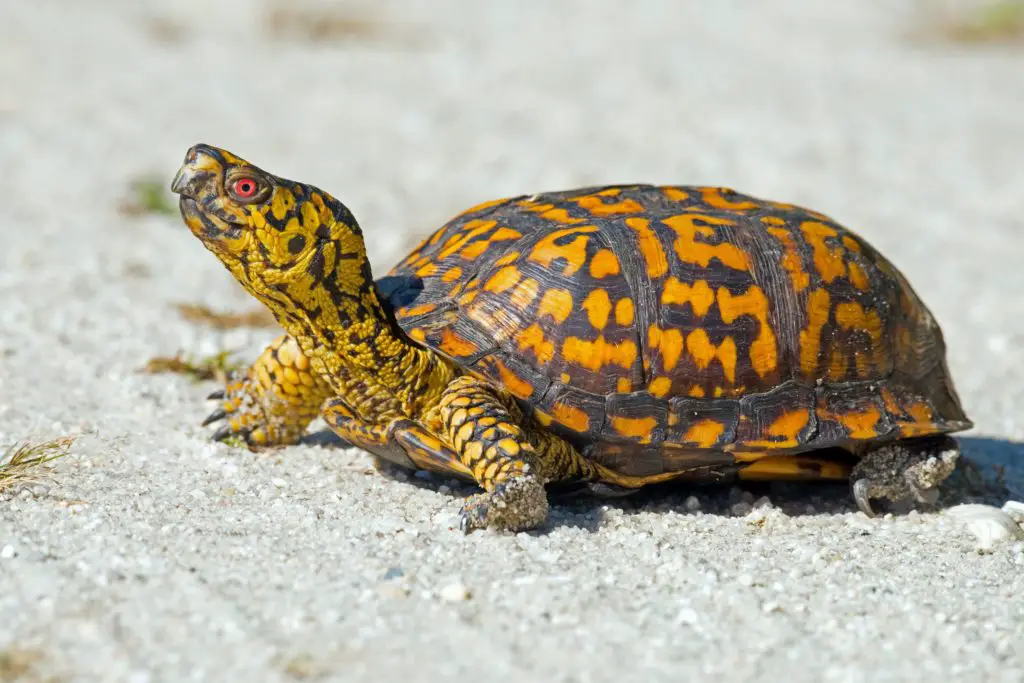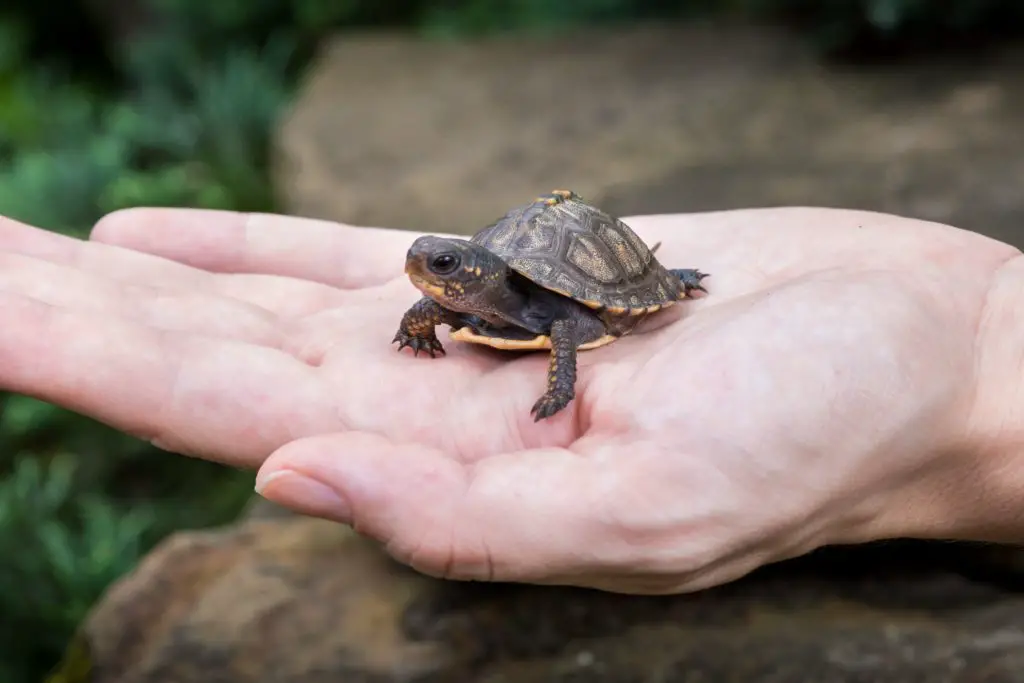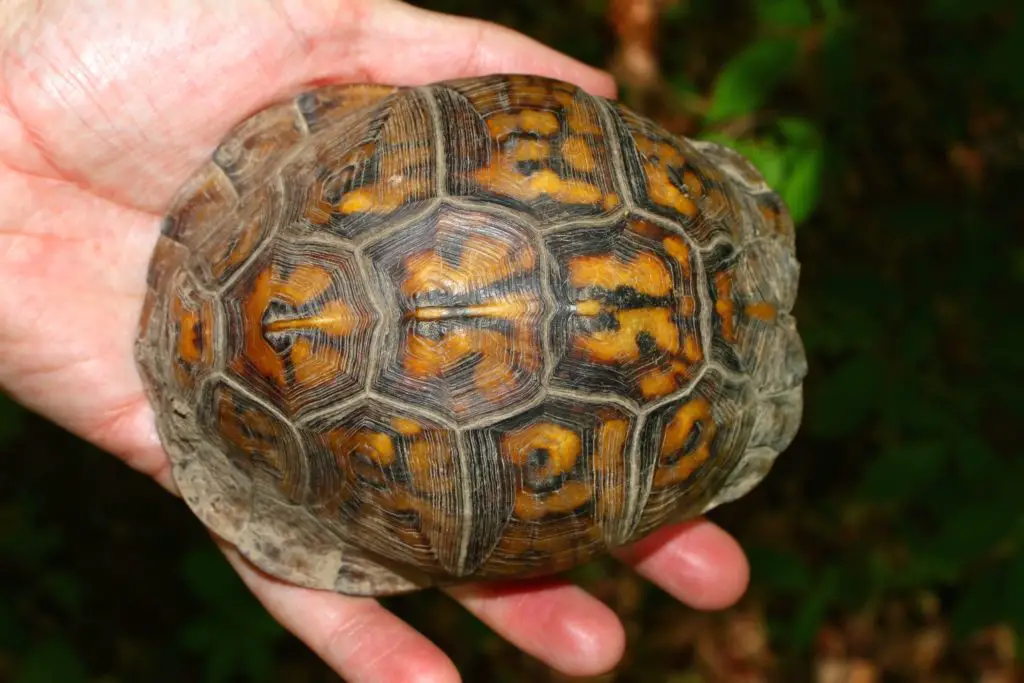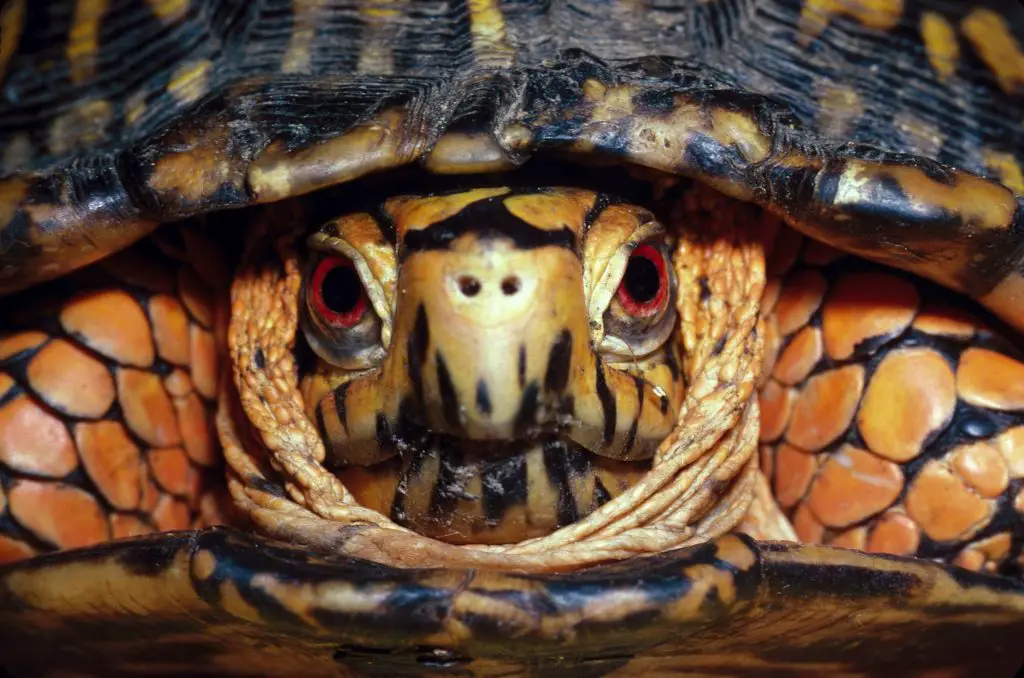Eastern Box Turtle habitat is always humid, but varies throughout the year depending on their needs. Keep reading to learn more…
Last updated on December 12th, 2022 at 06:33 pm
Eastern Box Turtles prefer the lush forest and meadows of the eastern United States. This type of habitat provides rich and varied food for omnivorous turtles like this one. It also provides humid ground to lay eggs in, as well as forests and marshy areas for escaping the summer heat.
Where does this turtle live?
Following our species profile focusing on this Terrapene subspecies, it’s time to take a look at Eastern Box Turtle habitat.
The Eastern Box Turtle is mainly found in the south-eastern United States. Many states like Texas and Maine are home to them around any areas that are high in vegetation which also means marshes and ponds.
They especially like living in places with warm weather like Florida. In parts of North Carolina, for example, they can be more common than further north.
This subspecies of this turtle isn’t officially endangered except for in a couple of states. However, reports have shown that some places are seeing a decline in their population in certain areas. Some states are declaring the Eastern Box Turtle as vulnerable at least, which in turn helps bring attention to them and get the turtles some protection.
Outside of the U.S, it is thought that Eastern Box Turtles were present in Ontario, Canada until a few centuries ago. According to the Ontario Turtle Conservation Centre, any Eastern Box Turtles found there now are probably released pets.
What kind of habitat do Eastern Box Turtles prefer?

Marshy meadows, forest, forest clearings, and areas of habitat adjacent to ponds are all favored by this turtle.
They like to live in places where there is a good amount of rainfall. They need high ambient humidity in their habitat and are most active during the mornings.
Eastern Box Turtles need an area to live in that has plenty of places to stay inside for safety whenever the weather changes. This includes when it’s too hot and when it’s too cold. This makes areas with some forest ideal.
These turtles need a somewhat even landscape, this is because they need an area to both warm themselves up in the sunlight, or cool themselves off in some water or even mud. They are fairly gentle creatures and they need a stress-free environment for them to live happily and healthily.
The importance of humidity
In the wild, these turtles rarely have to deal with low humidity, and they have evolved to grow and develop in a humid environment.
This is emphasized by the fact that in plains and other more dry areas, the Eastern Box Turtle (Terrapene c. carolina), is replaced by either the Ornate Box Turtle (T. o. ornata), or the Desert Box Turtle (T. o. luteola).
In captivity, keeping a close eye on your turtles’ humidity level is a very important step to keeping them healthy and living longer. It’s imputative to their health because it affects more than just one thing. Low humidity can have various repercussions – such as respiratory issues and skin problems.
Like most other animals and even us humans, once we become sick it gets harder for us to do things. This goes for turtles as well, they get weaker and eventually will stop eating or drinking.

How does their habitat use vary throughout the year?
Eastern Box Turtles seem to adapt and adjust to their surroundings whenever it’s necessary to do so. This includes incorporating different types of habitats and microhabitats into their home range.
Since turtles enjoy their fair share of sunlight, it’s no surprise that they alternate between marsh, woodland and open meadows. This allows them to sunbathe, but also cool off when needed.
On the hottest days, they are more partial to canopy-type coverages. This way it keeps their bodies cooler by using the shade to keep them covered. Eastern Box Turtles are so adaptable to their surroundings that they will actually reuse other habitats and coverages, like burrows made from other animals that have now moved on.
In spring, female turtles forget about their own comfort, and instead look for suitable areas to lay their eggs. This usually means damp, open meadows. You can read more about this here.
Choosing somewhere to hibernate
Eastern Box Turtles like to hibernate underground, below the frost layer. Once Autumn comes around, they retreat to any burrow made by other animals that have now moved on, or even just some loose soil.
They need a safe place to spend those colder months because they don’t hibernate like a lot of other animals, instead they go into more of a heavy daze type of sleep. In reptiles, this state is known as brumation.
Recent studies have shown that Box Turtles often travel considerable distances to their hibernacula, and that they often return to the same area, year after year. In many areas, they prefer to hibernate in woodland, though the reasons behind this are hard to determine.

Replicating Eastern Box Turtle habitat in captivity
It can be a bit hard to properly take care of an Eastern Box Turtle as an inside pet. They have specific needs just as any other animal to live their longest and best life.
So, if you are going to get one as a pet then it’s extremely important to do your research on them and see how well you think that you can replicate the same habitat for them. Get to know what kind of foods they eat, and their temperature and humidity requirements.
This can become a little pricey though depending on how much you’re wanting to go all out for them. If you have some room available that you would be able to give them, they can have everything they would have in their natural environment like several hiding places and a basking area, etc. right in their own indoor home.
If you are considering getting an Eastern Box Turtle for a pet, don’t forget that you need to check state and county laws first, and that you should only buy captive-bred animals to protect wild populations.
Can you keep a Box Turtle outdoors?
If your environment where you live will match with the turtles then it is definitely possible. Be sure to have the proper room for your box turtle outside where they can have enough room for exercise and has plenty of vegetation around to grow for their food. They also need to be safe from predators with places to adapt to the environment around them.
Keeping your box turtle outside in its own area is a plus for them if you have the time and means to do so. This is especially helpful for anyone that specifically takes care of box turtles, it gives them room to feel safe and trust you but also that you can in turn watch them and see how they act to things around them.
Taking care of any animal isn’t always the easiest thing to do. Especially with animals like turtles, they take a lot of research and patience to understand what they need. Eastern Box Turtles can be pretty easy to catch on to after taking care of one for a while so no matter if you want your turtle indoors or outdoors. As long as you can replicate their natural habitat fairly well then it can enjoy natural sunlight and keep itself regulated. There are plenty of different ways to keep you both happy.

The bottom line
Studying the habitat preferences of reptiles is essential for either observing them in the wild, or keeping them as pets.
With turtles in particular, it’s becoming more and more evident just how much habitat use influences their chances of survival.
This may be why the Eastern Box turtle is in decline throughout much of its range. It just can’t pick and choose between its preferred microhabitats when they’re obstructed by houses and roads.
